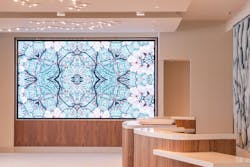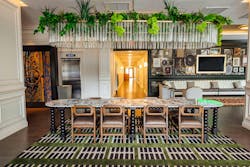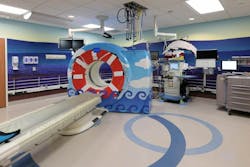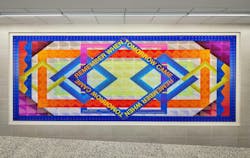Art in Interiors: Why Integrate Local Culture Into Commercial Spaces?
Key takeaways:
- Designers can cultivate authenticity in various spaces through community engagement, collaboration with local artisans, and regional materials sourcing when possible.
- Emphasize integration over decoration by creating cohesive spaces that meaningfully reflect local heritage, traditions, and geographical context.
- Meet sustainability and inclusivity objectives by incorporating sensory-friendly design elements that enhance accessibility while promoting cultural education and fostering a sense of belonging for all occupants.
Why we think this matters to design professionals: Authentic and sensitive artistic and cultural integration in commercial interiors creates competitive differentiation, attracting clients who seek sustainable, community-focused spaces that prioritize well-being of both people and the environment.
Art in architecture is essential as the commercial sector seeks to merge sustainability with inclusive design. Incorporating local cultural elements can elevate occupant experiences and create meaningful spaces through storytelling.
Artistic architectural details—indoors and out—reflect regional heritage and traditions, transforming buildings into cultural epicenters. Commercial environments can cultivate a sense of place and individualism to support surrounding communities.
Understand the Cultural and Geographical Context
Embracing a particular region’s cultural and geographical nuances demonstrates pride in the community. When leaning into architectural art, designers’ choices should resonate with locals and ensure structures and interior spaces reflect and contribute to the local heritage.
A 2024 study published in Frontiers in Psychology explains people’s connection to their surroundings as “place attachment.” Many feel a greater sense of belonging and identity when emotionally connected to their surroundings, forming a mental or physical bond as they experience their environment.
Art engages the community in developing the story of an interior design, preserves local culture, and vibrantly transforms spaces to foster interaction. Examples of art in architecture include installations such as murals, statues, memorials, and landscape designs. Interactive and digital art exhibitions are other possibilities in architectural contemporary art. These installations can relay socially enriching history, values, stories, and symbols unique to the area and its inhabitants.
Authentically Integrate Art and Interior Architecture
Authenticity is at the core of culturally relevant architecture in commercial spaces. Architectural artwork should be a fully integrated part of the interior environment, not merely decorative. Cohesive and culturally resonant designs create a meaningful space.
According to DLR Group's Staci Patton, when researching a project, her team spends time in the community to fully understand it. They explore the area, speak to locals, and stay for an extended period to learn how to mindfully incorporate the culture into their design narrative.
Inspiration can come from local culture, history, craftsmanship, and traditions. Collaboration with local artists and artisans is equally important for authentically representing an area and avoiding cultural appropriation.
Sourcing local materials and embracing traditional techniques and craftwork also supports regional economies and helps preserve heritage. This approach has the added benefit of reducing carbon dioxide emissions during construction and supply-chain logistics by encouraging designers to work with more sustainably sourced materials as well as with suppliers committed to eco-friendly practices.
Art in Hospitality and Community Centers
Hospitality and community venues for gathering are the cornerstones of many districts, delivering tremendous social and economic impact. They showcase local arts and entertainment, promote regional culinary traditions, grow awareness of diverse backgrounds, and encourage cultural exchange between residents and visitors. The following establishments are examples of several commercial spaces that have mastered the use of architectural art to define the local narrative and engage patrons.
The Thrift House in San Antonio
A community-oriented retail space, CREO Architecture interior designer Ann Hampton identified The Thrift House in San Antonio, Texas, as one of her most memorable projects. Directed by the Assistance League of San Antonio, The Thrift House embraces visitors with a vibrant mural painted by local artist Fresh Walls (shown above).
This retail space allows underserved children in the community to shop for clothes with a volunteer. For some, it is the first time they have independently picked out something to wear. The mural highlights the city’s vibrancy with a colorful backdrop of sunny weather and the San Antonio skyline, and its emphasis on ethnic representation helps all children feel welcome.
Hampton underscored the importance of giving local artists a voice in a project, noting that “You want that story to be told. …. I would say nine times out of ten, we’re just floored when we let [local artisans] have creative license.”
LUMA Hotel in San Francisco
On the Pacific Coast, San Francisco’s LUMA Hotel celebrates Mission Bay’s history and beauty through a wetland-inspired palette and spectacular waterfront views in a distinctly different application.
When guests walk through the lobby, they are greeted with a large mural that depicts the area’s original marshland and salt ponds before the city’s infrastructural boom in the 1800s. Meanwhile, white flooring and sleek wooden panels pay homage to San Francisco’s modern identity as a high-tech business incubator.
Soft blues, greens, and grays dominate the boutique hotel and evoke some of the textures and organic aesthetics of its surroundings, harmonizing the natural environment and contemporary features of the design. Recyclable materials and low-energy lighting support a sustainable design, allowing LUMA to maintain a LEED Silver certification.
Hotel Tonnelle in New Orleans
Hotel Tonnelle in New Orleans underwent a striking renovation with //3877 to reflect its eclectic Garden District location, with the property’s lush live oaks bringing outdoor inspiration to the interior. A blend of green hues and jewel tones meets vintage and one-of-a-kind decor to tie the hotel’s Victorian design to the landscape.
Upgrades concentrated on creating a cozy and communal lobby with local artwork, a small library, and whimsical textiles, such as a Tibetan tiger rug. Some of the details were more about curating treasures that already existed in the local furnishing and arts economy. Reflecting on the project, //3877 senior associate Molly Forman, NCIDQ, said, “Our favorite design elements were ones where we got to engage with the community to curate things specifically for this space.”
For instance, the design team worked with local shops to acquire the reception desk’s chandelier, repurposed an old fireplace in the lobby, and utilized various pottery tiles from prominent New Orleans streets.
Artwork Elevates Commercial and Institutional Spaces
Artistic architecture appears beyond the hospitality industry, from transportation centers to government buildings, schools, and healthcare facilities. Meaningful artwork can create a unique brand or location identity, improve wayfinding, and make occupants feel more connected to both their surroundings and their purpose.
Studies have long shown that even when passively viewed, artwork can be grounding and calming to people in medical settings, as reported in the American Journal of Public Health. As a result, artistic elements have been introduced into children’s hospitals, like CHOC Children’s in Orange County, California, to help reduce young patients’ fears. In a collaboration with the nonprofit RxArt, artist Rob Pruitt transformed the radiology suite and corridor with a whimsical seascape and nautical theme to set children’s minds at ease for positive outcome.
In an entirely different environment, art can connect workers to their organization’s mission and provide navigation cues. For example, in Indianapolis, the Major General Emmett J. Bean Federal Center—a massive military workplace—features 17 large custom-painted murals that depict battlefields central to American military history. In working with the General Services Administration and design team, artist Adam Cvijanovic opted to focus on the landscapes, rather than depict people in conflict, to orient occupants to different areas within the facility’s many long corridors—and provide a reminder of the past’s connection to the present work.
The Pacific Park Campus of Intermediate School 653 in Brooklyn, New York, is also no stranger to embedding interior artwork that connects students and staff with the wider neighborhood, to generate a sense of belonging. The artistic duo Ghost of a Dream created a captivating glass mural with the phrase “Remember When Tomorrow Came” repeated in 170 languages. The different languages represent the vast multiculturalism of the local residents, while interlocking geometric shapes symbolize unity within this diverse community.
Forward-Thinking Approaches to Artistic Integration
Sustainability and inclusivity are principles that continue to influence the direction of architecture and interior design. As previously mentioned, a sense of belonging within a space—as well as furnishing a built environment that respects the locale, residents, and culture—creates a greater connection between people, place, and purpose.
Sensory design is a key trend in improving the human experience in the built environment. A 2022 study from the Journal of the Academy of Marketing Science found that sensory design fosters belonging and familiarity, and it may provide opportunities to educate others and promote acceptance. These benefits can also apply to interior artworks and design elements. Touchable elements, audio, and careful placement of art allow individuals of all abilities to enjoy each space. Sensory-friendly considerations—such as soft lighting, soothing colors, and acoustic management—can positively impact occupants and ensure everyone feels welcome.
It’s even possible to extend the concept of inclusion to the design and build process itself. Vernacular architecture is a prime example of both sustainable and inclusive design. According to a 2024 study in the Journal of Asian Architecture and Building Engineering, vernacular architecture involves constructing the built environment without plans, encouraging community participation and sourcing local materials. Such structures reflect regional culture, traditions, skills, and history in an entirely new light.
Localization Is Integral to Cultural and Artistic Preservation
Commercial spaces are a perfect backdrop for local culture and art. Artistic interior elements support thought-provoking, inclusive, and sustainable environments for communities, residents, and visitors while celebrating the individual story of their regions.
About the Author

Rose Morrison
Rose Morrison has more than five years’ experience writing about key topics in real estate, building, and construction, including sustainability, technology innovation, and trends that translate to home and commercial markets. She currently serves as managing editor of Renovated.






